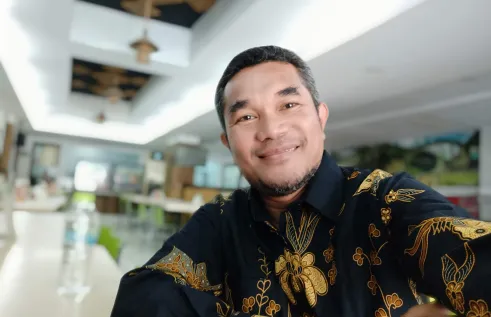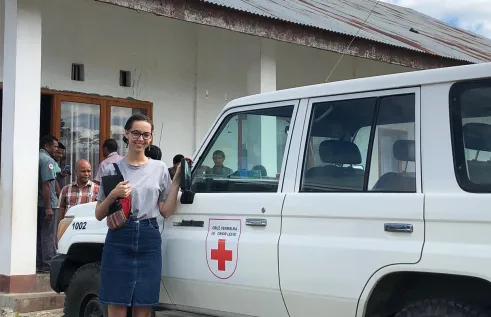Research impact
How can Indonesia address its vulnerability to earthquakes?

In the wake of a major earthquake on the island of Lombok in Indonesia, Dr Jonatan Lassa, a senior lecturer in Humanitarian, Emergency and Disaster Management at CDU, asks the question: is it time for Indonesia to embrace radical change? See why he's calling on authorities to prepare for tourists, look beyond technological solutions, and act now with building standards reform.
To save lives, we need to move beyond the idea that perfect risk assessment exists
An earthquake on Lombok island in Indonesia has left 460 people dead and more than 380,000 people homeless, according to the National Disaster Mitigation Agency.
Around 70% of North Lombok’s housing stock has either collapsed or been severely damaged. Just a week earlier, a 6.5-magnitude earthquake hit a nearby region, destroying tens of houses and claiming 10 lives, and injuring more than a dozen people.
As the area recovers, we need to ask: how can Indonesia address its vulnerability to earthquakes?
We know that Indonesia can improve its response to natural disasters, which has happened with tsunami preparedness. The next challenge is to apply these lessons to seismic activity.
Prepare for tourists
Thousands of tourists were caught in panic after both earthquakes. It’s time for Indonesia’s emergency systems to address the vulnerability of foreign visitors, as well as its own citizens.
The past 30 years have been filled with wake-up calls. A 1992 earthquake that struck Flores island caused 15,000 houses to collapse in a single district alone. It took almost 20 years for tourism to recover.
With tourism on the rise in many earthquake-prone areas, solid preparation measures must be put in place to address the vulnerable hotels and fragile houses that jeopardise tourism’s future.
More technology isn't the answer
Technology may seem like the answer, because it's often easier to attract international funding for sophisticated new systems for hazard prediction and monitoring. For example, the Australian-funded Inasafe has the potential to help governments develop scenarios for better planning, preparedness and response activities. The US-funded Inaware is a disaster management tool aimed at improving Indonesia’s risk assessment and early warning systems.
It isn't clear how these technologies will help small hotels or households in earthquake-prone regions.
What they really need is help to build structures in accordance with proper construction codes, so that these buildings don’t become death traps during an earthquake.
This points to a deeper problem. Such building codes already exist, but local governments are currently showing little desire to comply with national building regulations.
For example, before 2011, less than 12% of local governments adopted and endorsed the Building Law 2002. By 2016 that figure had risen to 60% – an improvement, but still not enough.
In North Lombok, where most houses collapsed in the recent earthquakes, the local government only endorsed the national building regulations in 2011. It will take years for the local administrators to actually implement them.
The no-regret approach
Seismic mitigation measures need to start immediately, at the local level. Thousands of building are built every day and right now, while many are rebuilding after disaster, is the time for local governments to put the codes and standards that exist at a national level in to practise.
Instead of waiting for decades to conduct detailed down-scaled seismic risk mapping, some actions must be taken now.
Local and central governments can embrace innovation. Central government and local governments in Indonesia must focus on transforming the way houses are built, including checking earthquake preparedness when issuing building permits.
Can local government radically audit all vulnerable houses? And can we create a machine of local bureaucrats who can deal with the risk assessment on every single house in earthquake prone regions?
It may seem hard, but good practices are already available. Apart from creating incentives for local engineers, contractors and building consultants to be mindful of seismic measures, local governments can also gradually audit critical public buildings that are particularly crucial to disaster response (and may be especially dangerous if they collapse).
Indonesia could even follow California’s example and publicly shame the owners of buildings that the building code.
It will require radical reform in public administration, including construction at local level. Without this radical change, the status quo will remain and people will continued to be killed by their houses when moderate to big earthquakes hit their area.
The present approach is failing. Stronger political and administrative commitments are needed at all levels.
Authored by Dr Jonatan Lassa, a senior lecturer in Humanitarian, Emergency and Disaster Management at CDU. Dr Lassa is an interdisciplinary social scientist with an engineering background. This article has been adapted from an article originally published on The Conversation.
Want to join the disaster management industry or go further in your current career? Study your way to success with a course in Humanitarian, Emergency and Disaster Management from CDU. You'll learn from industry experts, examine real-life case studies, and benefit from close connections with government, NGOs and leading aid agencies. Explore our courses.
Related Articles

Mohammad dreams of building disaster-resilient communities
Mohammad dreams of developing disaster-resilient communities in Indonesia, so he began his search for a Higher Degree by Research and was granted an Australia Awards Scholarship. His research could make a big impact on small islands threatened by a host of natural disasters.
Read more about Mohammad dreams of building disaster-resilient communities
Age is no barrier to making an impact in emergencies
Meet the emergency services veteran who, at 80, went to university to consolidate a lifetime of on-the-job learning and help shape the future direction of emergency management.
Read more about Age is no barrier to making an impact in emergencies
Theory in action: Stephanie's overseas placement
In her final year of a Bachelor of Humanitarian and Community Studies, Stephanie completed a student placement with the Red Cross in Timor-Leste. She reflects on the placement – and dissects why it was such a formative personal, professional, and academic experience.
Read more about Theory in action: Stephanie's overseas placement
